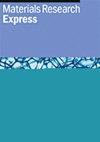Fabrication and characterization of silver thin films using physical vapor deposition, and the investigation of annealing effects on their structures
IF 2.2
4区 材料科学
Q3 MATERIALS SCIENCE, MULTIDISCIPLINARY
引用次数: 24
Abstract
Silver nanoparticles have attracted increasing interest due to their chemical stability, catalytic activity, localized surface plasma resonance, and high conductivity. In this article, silver thin films with a thickness of ∼20 nm were fabricated on commercial glass (20 mm × 20 mm) substrate using physical vapor deposition technique, through the bombardment of the electron beam. To check the effect of annealing temperature, the fabricated substrates were annealed at the temperature range of 373.15 K to 1073.15 K with the difference of 100 K under a vacuum condition of ∼0.99 bar at constant time of 20 min; in addition, a single sample that had undergone no annealing effect has also been provided as a reference substrate. We investigated the physical and morphology evaluation information of fabricated annealed silver thin films on the glass substrate using the Ultra-Violet and Visible (UV–vis) spectroscopy, x-ray diffraction (XRD) and the field emission scanning electron microscope (FE-SEM) and energy dispersive spectroscopy (EDS). The results obtained from this study show that by increasing the annealing temperature of silver thin films, the flat silver thin films changed into rough silver thin films, by further increment change the silver thin films into silver nano-particles. At the annealed temperature of 1073.15 K, the 20 nm silver thin film was completely removed from the glass as well as bending occurred on the glass substrate. In the end, the absorbance spectra of each sample and the referenced sample were also measured.用物理气相沉积法制备和表征银薄膜,并研究退火对其结构的影响
银纳米颗粒由于其化学稳定性、催化活性、局部表面等离子体共振和高导电性而引起越来越多的兴趣。在本文中,利用物理气相沉积技术,通过电子束轰击,在商用玻璃(20mm × 20mm)衬底上制备了厚度为~ 20nm的银薄膜。为了检验退火温度的影响,在真空条件为~ 0.99 bar,恒定时间为20 min的条件下,在373.15 ~ 1073.15 K的温度范围内退火,差值为100 K;此外,还提供了未经历退火效应的单一样品作为参考底物。利用紫外、可见光谱(UV-vis)、x射线衍射(XRD)、场发射扫描电镜(FE-SEM)和能谱(EDS)研究了在玻璃基板上制备的退火银薄膜的物理和形貌评价信息。研究结果表明,通过提高银薄膜的退火温度,平坦的银薄膜转变为粗糙的银薄膜,通过进一步的增加,银薄膜转变为纳米银颗粒。在1073.15 K的退火温度下,20 nm的银薄膜从玻璃上完全脱落,并且在玻璃基板上发生弯曲。最后测量了各样品和参考样品的吸光度光谱。
本文章由计算机程序翻译,如有差异,请以英文原文为准。
求助全文
约1分钟内获得全文
求助全文
来源期刊

Materials Research Express
MATERIALS SCIENCE, MULTIDISCIPLINARY-
CiteScore
4.50
自引率
4.30%
发文量
640
审稿时长
12 weeks
期刊介绍:
A broad, rapid peer-review journal publishing new experimental and theoretical research on the design, fabrication, properties and applications of all classes of materials.
 求助内容:
求助内容: 应助结果提醒方式:
应助结果提醒方式:


